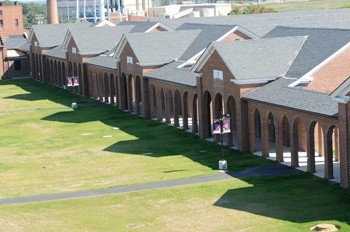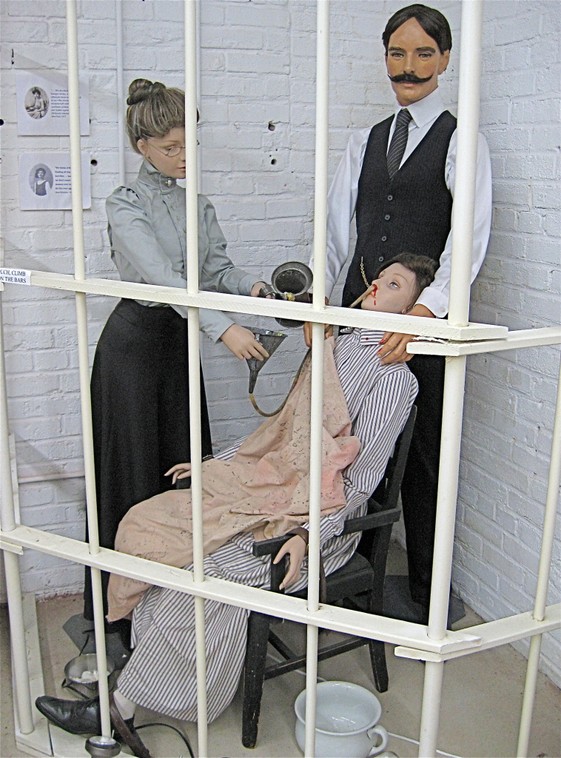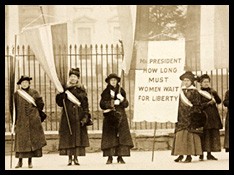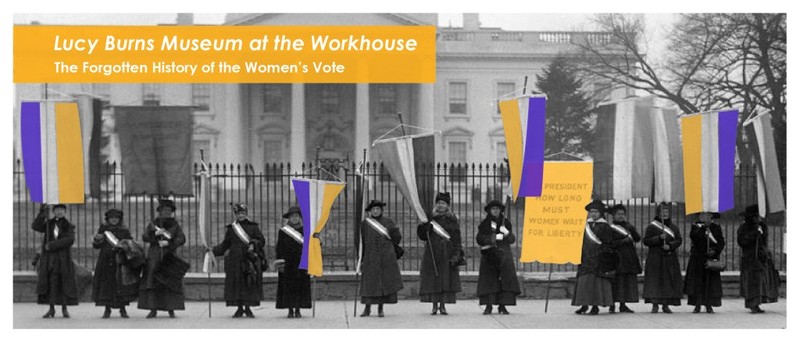Workhouse Arts Center/Workhouse Prison Museum
Introduction
Text-to-speech Audio
Images
Workhouse Prison Museum in Lorton (reproduced under fair use).

Exhibits showcasing force-feeding and torture at the workhouse, Workhouse Museum (reproduced under fair use).

Women suffragists protesting outside in Washington DC, Library of Congress (public domain).


Workhouse, price c. 1948. Courtesy of the Orsinger Collection at the Workhouse Museum (reproduced under fair use)..

Backstory and Context
Text-to-speech Audio
The District of Columbia’s Workhouse opened in Lorton, Virginia in the summer of 1910 and was initially created as an experiment to determine if hard labor and an open-air environment would be beneficial to help reform “short-term prisoners who were habitual drunkards, vagrants, and family abusers.”1 The U.S. government purchased 3,200 acres of land for the Workhouse at the cost of $28,650 on April 1st, 1910 with the intent of establishing an industrial farm and worksite for prisoners.2 Initially, there were no built structures for the prisoners and they had to use tents and temporary structures.3 Eventually, a brickyard was built and the fields were converted and used for cultivation. The inmates used the bricks they made in the brickyard onsite to build the brick dormitory buildings that remain standing today. In 1912, there was also a Women’s Workhouse that was opened nearby that housed women sentenced for smaller charges like soliciting, prostitution, and disorderly conduct. The National Register of Historic Places approved this site for statewide status on February 2, 2012, which was amended from a previous request in 2005.4
A notable contribution to the history of this site was its involvement in the women’s suffrage movement. In 1917, women began demonstrating in front of the White House for the right to vote and decided they would rather be imprisoned than be quiet.5 Some of the women that were arrested were sentenced to the Women’s Workhouse at Lorton. What is most notable about their imprisonment was that the women were held under “deplorable conditions.”6 These women, also known as the Silent Sentinels, “endured unspeakable torture and abuse at the hands of more than 40 prison officials and guards.”7 These women were served rancid food, were chained and beaten, “some by having their heads smashed into iron bed frames, and one woman, a 74-year old suffragette, was stabbed with part of her broken picketing banner.”8 The suffragists claimed status as political prisoners but were denied access to counsel and when one group of suffragists began a hunger strike to protest the prison‘s lack of recognition of their political prisoner status, they were forcibly fed through feeding tubes.9 These events and the history surrounding these women are featured in current the museum at the Workhouse Arts Center.
In 1936, the Workhouse was converted into a maximum-security facility and was later overseen by the District of Columbia’s Department of Corrections that was created to supervise the Lorton Complex in 1946.10 During this time, the complex saw multiple changes to support the new security requirements and help support the maximum-security facility. Between 1950 and 1952 a reformatory fence and lights were installed and there was also an increase in violence from prisoners. These facilities were in poor condition and overcrowded.11 In 1958, the first officer was killed on site in the line of duty and the first major riot at the prison occurred in 1963. With these changes and challenges to the facility, the men and women’s workhouses closed in 1966 along with the farming and agriculture branches that followed in 1995. Also in 1995, the Federal Trustees took over responsibility for the complex and turned it into a super-maximum security prison. The federal government took over because the D.C. government was unable to “resolve the facility’s problems.”12 Around the late 1990s, the prison was thought of as “an oppressive, poorly managed prison where escapes and riots often have made news and guards sometimes have been charged with crimes themselves.”13 Interestingly, Congress turned over the prison complex to Fairfax County, where Lorton is located, and the Fairfax Water Authority took control of the site in 1998.
Because of the mismanaged and overcrowded conditions, the prison was closed with the last prisoner leaving in December 2001. In 2002, 2,324 acres were sold to Fairfax County for 4.2 million dollars.14 The Lorton Arts foundation was approved to open the Workhouse Art Center in 2004. The Workhouse Arts Center officially opened in 2008, with a museum following later that year. There are numerous artists that have shops throughout the current complex, and there are many options, from food to theater classes that are offered at the arts center.15 There are several opportunities for visitors interact with artists and to participate in the many performing arts opportunities and classes available.16
Sources
1. Workhouse Prison Museum at Lorton. Accessed October 15, 2017. http://workhousemuseums.org/
2. Wheeler, Linda. No Escaping the History of Lorton Prison. The Washington Post. February 07, 1999. Accessed October 16, 2017. https://www.washingtonpost.com/archive/local/1999/02/07/no-escaping-the-history-of-lorton-prison/9f8....
3. The District of Columbia's Workhouse at Lorton. Workhouse Prison Museum at Lorton. Accessed October 16, 2017. http://workhousemuseums.org/history/the-district-of-columnbias-workhouse-at-lorton/.
4. National Register of Historic Places Registration Form. Fairfax County. Accessed October 16, 2017. https://www.fairfaxcounty.gov/dpz/laurelhill/natlregister/029-0947_dc_workhouse_hd_2012_revision_nrh....
5. About. Workhouse Prison Museum at Lorton. Accessed October 16, 2017. http://workhousemuseums.org/about/.
6. About. Workhouse Prison Museum at Lorton. Accessed October 16, 2017. http://workhousemuseums.org/about/.
7. Strock, Anna. This Abandoned Prison in Virginia has a Truly Terrifying History. Only In Your State. November 17, 2015. Accessed October 16, 2017. http://www.onlyinyourstate.com/Virginia/abandoned-lorton-reformatory-va.
8. Strock, Anna. This Abandoned Prison in Virginia has a Truly Terrifying History. Only In Your State. November 17, 2015. Accessed October 16, 2017. http://www.onlyinyourstate.com/Virginia/abandoned-lorton-reformatory-va.
9. National Register of Historic Places Registration Form. Fairfax County. Accessed October 16, 2017. https://www.fairfaxcounty.gov/dpz/laurelhill/natlregister/029-0947_dc_workhouse_hd_2012_revision_nrh....
10. D.C. Department of Corrections Facility at Lorton Prison Complex Time Line. Workhouse Prison Museum at Lorton. Accessed October 16, 2017. http://workhousemuseums.org/history/d-c-department-of-corrections-facility-at-lorton-prison-complex-....
11. National Register of Historic Places Registration Form. Fairfax County. Accessed October 16, 2017. https://www.fairfaxcounty.gov/dpz/laurelhill/natlregister/029-0947_dc_workhouse_hd_2012_revision_nrh....
12. Wheeler, Linda. No Escaping the History of Lorton Prison. The Washington Post. February 07, 1999. Accessed October 16, 2017. https://www.washingtonpost.com/archive/local/1999/02/07/no-escaping-the-history-of-lorton-prison/9f8....
13. Wheeler, Linda. No Escaping the History of Lorton Prison. The Washington Post. February 07, 1999. Accessed October 16, 2017. https://www.washingtonpost.com/archive/local/1999/02/07/no-escaping-the-history-of-lorton-prison/9f8....
14. About. Workhouse Prison Museum at Lorton. Accessed October 16, 2017. http://workhousemuseums.org/about/.
15. Lorton, Virginia: Lorton Workhouse Museum - Suffragettes Behind Bars. Roadside America. Accessed October 16, 2017. https://www.roadsideamerica.com/tip/27591.
16. Lorton, Virginia: Lorton Workhouse Museum - Suffragettes Behind Bars. Roadside America. Accessed October 16, 2017. https://www.roadsideamerica.com/tip/27591.
http://workhousemuseums.org/
http://workhousemuseums.org/exhibits/
https://www.loc.gov/item/mnwp000212
https://workhousemuseums.org/about/
